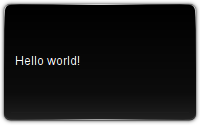Development/Tutorials/Plasma4/Ruby/Using widgets: Difference between revisions
Translation of the Python 'Using widgets' tutorial. I removed the lines about the SVG theme because it didn't seem to do anything, feel free to correct me. |
m Forgot to change one '.py' to '.rb' |
||
| Line 11: | Line 11: | ||
== The 'main.rb' file == | == The 'main.rb' file == | ||
Here is how our main. | Here is how our main.rb file will look like: | ||
<code ruby> | <code ruby> | ||
Revision as of 21:07, 25 January 2009
This is a 'translation' of the Using widgets article on Python and Plasma. For the Python Tutorial see here.
Abstract
Using the paintInterface method to display applets is a powerful, and sometimes even necessary way of working. For example, when you want to display a SVG graphic. But it is not the only method available to create a Plasmoid, however. Plasma comes with a number of widgets "tailored" for use in Plasmoids. In this tutorial we will create a very simple "Hello, world!" Plasmoid using Plasma widgets.
Prerequisites
Set up your applet directory and create a metadata.desktop file as described in the Getting Started tutorial.
The 'main.rb' file
Here is how our main.rb file will look like:
- Copyright stuff
require 'plasma_applet'
module RubyStart
class Main < PlasmaScripting::Applet
def initialize parent
super parent
end
def init
self.has_configuration_interface = false
self.aspect_ratio_mode = Plasma::Square
self.background_hints = Plasma::Applet.DefaultBackground
layout = Qt::GraphicsLinearLayout.new Qt::Horizontal, self
label = Plasma::Label.new self
label.text = "Hello world!"
self.layout.add_item label
self.layout = layout
resize 125, 125
end
end
end
Let's take a deeper look at it. As in the main tutorial, we create our class by deriving from the PlasmaScripting::Applet class. In initialize, we quickly initialize the class. We use the init method instead to do all the dirty work of creating the applet and adding the widget needed to display the text.
First of all we tell Plasma that this applet does not have a configuration dialog (has_configuration_interface=). We then set the aspect ratio mode to a square (Plasma::Square). This is taken into account when someone resizes the applet. Next the background_hints= method sets the Plasmoid's background to the default Plasma background (Plasma::Applet.DefaultBackground) saving us from having to manually draw the background ourselves.
The third and most important step deals with creating a layout. It is a bit different than the standard Qt::LinearLayout seen in Qt, because it is done inside a Qt::GraphicsView used by Plasma. We want a simple, linear layout, and so we use a Qt::GraphicsLinearLayout, setting it to be horizontal (Qt::Horizontal).
Next we create a Plasma::Label. This is a widget that is Plasma aware and therefore uses all of the goodies provided by Plasma. For example, automatically changing its text color if the Plasma theme changes. We then use the text= method (analogous to the normal Qt::Label.text= method) to set our label text ("Hello, world!") and then add the label to the layout. Also, we set the applet's layout to be the one we have just defined using self.layout=. Finally we resize the applet to 125 x 125 pixels.
Once packaged and installed (see the Getting Started tutorial), the Plasmoid will look like this:

Conclusion
This brief tutorial shows how to use Plasma widgets with your applet. Beside Plasma::Label there are many more widgets that you can use.
Notice that at the moment you can only add widgets and create layouts directly in code. This means you can't use an application like Qt Designer to design the appearance of your applet.
